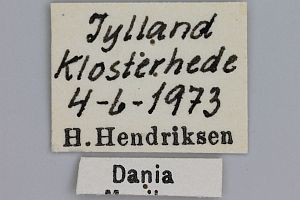

 +21Kontinente:EUAS
+21Kontinente:EUAS2. Diagnose
2.1. Geschlecht nicht bestimmt
2.2. Erstbeschreibung
3. Biologie
3.1. Nahrung der Raupe
- [Orobanchaceae:] Pedicularis palustris (Sumpf-Läusekraut)
- [Menyanthaceae:] Menyanthes trifoliata ?? (Fieberklee ??)
- [Juncaginaceae:] Triglochin ??? (Dreizack ???)
Beavan & Heckford (2012: 71) erläutern in ihrer Arbeit zu Gynnidomorpha permixtana: "Barrett (1881: 70) observed the species at the beginning of June 1881, again ‘near Pembroke’, exact locality and habitat not given. He states that the foodplant was still unknown and that a rumour that it had been bred from Pedicularis palustris L. did not seem to be confirmed. Pedicularis palustris was subsequently shown by Richardson (1891: 239–240; 1892: 173–176) to be the larval foodplant of the very similar Gynnidomorpha minimana (Caradja, 1916)."
Kennel (1908: 276) hatte zu "Phalonia geyeriana HS." noch einmal Richtiges und Falsches miteinander vermengt: "Die Raupe ist blaß bräunlich, Kopf und Nackenschild sind schwarzbraun ; sie lebt vom Herbst bis Frühling in Samenkapseln von Pedicularis palustris; nach Sorhagen auch in Blütenstielen von Alisma plantago".
Angaben zu Menyanthes oder Triglochin bei Razowski (2001: 38) sind mit einiger bzw. hoher Wahrscheinlichkeit falsch. Die Angabe zu Triglochin dürfte auf einer Verwechslung mit Gynnidomorpha vectisana beruhen.
Hancock et al. (2015: 48) wiederholen allerdings den Fieberklee, leider ohne Primärangabe: "Feeds in seed capsules of marsh lousewort (Pedicularis palustris) in July and again in September. Larvae also reared from seedpods of bog-bean (Menyanthes trifoliata) (Bradley, Tremewan and Smith, 1973)."
(Autor: Erwin Rennwald)
4. Weitere Informationen
4.1. Andere Kombinationen
- Conchylis minimana Caradja, 1916 [Originalkombination]
4.2. Synonyme
- Phalonia walsinghamana Meyrick, 1928
4.3. Faunistik
Zum Vorkommen in Deutschland siehe Segerer et al. (2013).
4.4. Literatur
- Beavan, S. D. & R. J. Heckford (2012): Discovery of the larva of Gynnidomorpha permixtana ([Denis & Schiffermüller], 1775) (Lepidoptera: Tortricidae) in the British Isles and a consideration of the species' distribution there. — Entomologist's Gazette 63: 69-83 [PDF auf devonmoths.org.uk].
- Erstbeschreibung: Caradja, A. (1916): Beitrag zur Kenntnis der geographischen Verbreitung der Pyraliden und Tortriciden des europäischen Faunengebietes, nebst Beschreibung neuer Formen. — Deutsche Entomologische Zeitschrift „Iris“ 30: 1-88, 151-152. Dresden.
- Hancock, E.F., Bland, K.P. & J. Razowski (2015): The moths and butterflies of Great Britain and Ireland. Volume 5 (Part 1). Tortricidae, Tortricinae & Chlidanotinae. - 245 S.; Leiden & Boston (Brill).
- Kennel, J. (1908): Die Palaearktischen Tortriciden. Eine monographische Darstellung. — Zoologica, 21 (54): 1-546. [PDF auf zobodat.at]
- Razowski, J. (2001): Die Tortriciden (Lepidoptera, Tortricidae) Mitteleuropas. Bestimmung - Verbreitung - Flugstandort - Lebensweise der Raupen. — 319 S.; Bratislava.
- Richardson, N.M. (1891): The larva of Eupoecilia geyeriana. — The Entomologist’s Monthly Magazine, 27: 239–240. [Digitalisat auf biodiversitylibrary.org]
- Segerer, A. H., Lichtmannecker, P., Grünewald, T. & E. Lohberger (2013): Aktuelle Vorkommen einiger wenig bekannter Schmetterlingsarten in Deutschland (Lepidoptera, Nepticulidae, Gracillariidae, Gelechiidae, Tortricidae, Crambidae). — Entomologische Nachrichten und Berichte 57 (3): 121-126.



























